If you know a thing or two about keeping your car’s paintwork smooth and polished, you may already be aware that just a standard wash won’t always be enough. Clay bars can take off dirt and particles that are too stubborn for a regular wash. But for a clay bar to be effective, you need to use the right kind, and that’s where knowing the differences between the various types comes in handy.
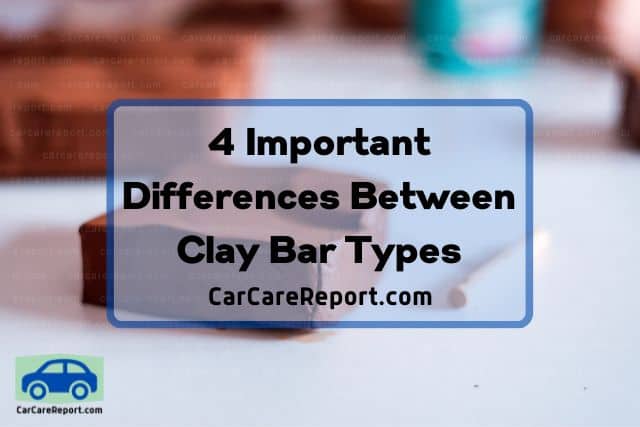
The four important differences between clay bar types are:
- Strength
- Flexibility
- Frequency of Use
- Type of Material
This article will look into these differences in more detail and explain how they dictate what you will use the various clay bar types for. I’ll also answer a few common questions about using clay bars later on, so be sure to read to the last word.
1. Strength
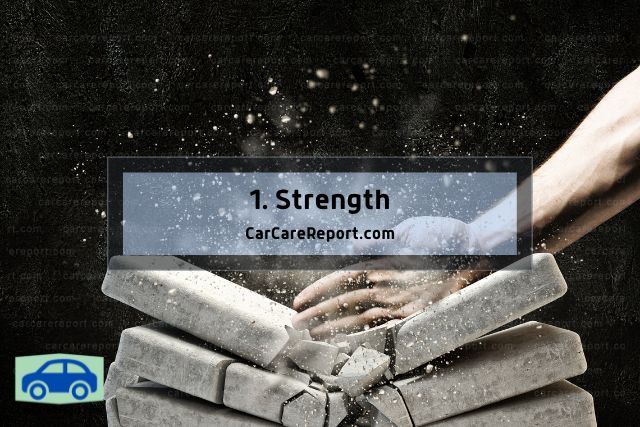
Clay bars are made of a flexible resin, not actually clay. They’re designed to be abrasive enough to remove dirt or particles from vehicles’ paintwork while being flexible enough to push over the paint’s surface by hand.
The strength of the clay bar depends on the thickness of the material. There are three primary types of clay bar, and each type refers to a different thickness:
- Light
- Medium
- Heavy
Here’s a rundown of how each type should be used:
Light Clay Bars Can Be Used to Clean Your Car Regularly
Finer clay bars are less abrasive than other types and will not be able to remove all types of particles from your vehicle’s body. However, they are still useful for regular claying.
Professionals recommend using a light clay bar on cars in normal weather and lightly contaminated environments. Remember, even a finer clay bar will have some abrasiveness to it, and you should also use polish and lubricant to keep the shine on your bodywork.
Light clay bars can be used for general grime, lighter amounts of tar, or similar day-to-day pollution. You won’t need to do this regularly unless you are extremely passionate about keeping the surface of your car smooth.
Medium Clay Bars Are Effective Against Tougher Dirt or Grime
Medium strength clay bars are more abrasive than light clay bars and more suitable for bigger cleaning jobs. It would be best to use a medium clay bar on cars that have not been properly cleaned for a long time or have heavier particles to be removed.
Generally, a medium clay bar is used for pollutants or other stubborn dirt that stick to the bodywork, but not for a standard claying job when the car is grimy.
Examples of pollutants you should use a medium clay bar to tackle are build-ups of road tar, bird droppings, and tree sap that has stuck to your paintwork for a while.
Heavy Clay Bars for Very Difficult Cleaning Jobs, Metal, and Glass
Ideally, you would never need to use a heavy clay bar because these are reserved for cars that have not been looked after for a long time or are covered in the worst pollutants or dirt. But since things aren’t always perfect in the real world, you might need one of these now and then.
If you do have to use a heavy clay bar, exercise extreme caution because it’s the most abrasive type of clay bar. If you’re not careful, you can cause damage to your paintwork that will be much more difficult to fix than pollutants and grime.
Always clean off particles or dirt from your car with light or medium strength clay bars before resorting to the heavier grade. Examples of situations where a clay bar would have to be used are chemical pollution or restoring a car left outdoors for a long time.
One benefit of heavy clay bars is that although they are extremely abrasive to paintwork, they are not abrasive to stronger materials. That makes them perfect for cleaning harder surfaces such as glass windshields.
2. Flexibility
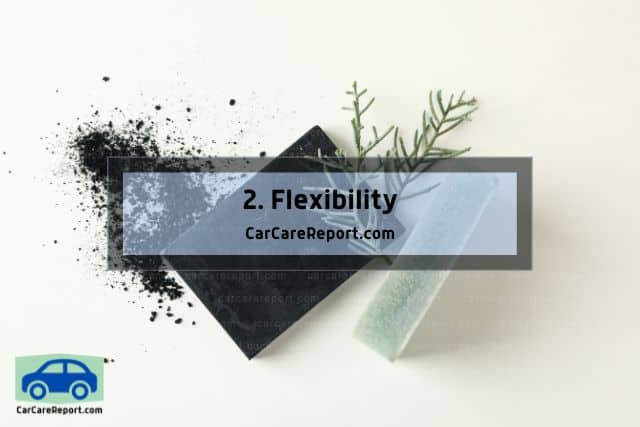
As you may expect, the strength or thickness of the clay bar will affect how easily you can bend or mold it into shape during use. This will affect how easily and quickly you can rub the clay bar over the surface of your paintwork, especially when working on harder-to-access parts o your car.
Generally, the thicker the clay bar, the less flexible it is:
Light Clay Bars Mold Easily on Your Cars Bodywork
The resins in light clay bars are finer. Therefore, these clay bars are more malleable than their medium and heavier counterparts. That makes it easier to use light clay bars, especially if your car doesn’t have too much grime and only needs a once-over.
Light clay bars make a great starting point if you’re new to claying. Not only are they easy to work with, but they also carry the least risk of ruining your paint job.
Medium Clay Bars Are Tougher and Less Flexible
Due to the higher strength, medium clay bars will not be as malleable as light ones. They’re somewhere in the middle between light and heavy clay bars in terms of how easily they’ll shape around the shape of your bodywork.
Medium clay bars will take out more stubborn dirt and pollutants. As a result, you will need to scrub a little more intensely and go over the same spot to ensure that spots with such grime are well attended to.
Heavy Clay Bars Need the Most Time to Go Over Staining on Your Car’s Paint
As you may expect, this is the least malleable of the clay bar types and is not friendly for regular use. To use a heavy clay bar on your paintwork, you will need to put in a lot of effort when scraping off tough particles, which causes more scraping to the car and leaves it needing extra polish afterward.
It would be best to be very careful when going over contaminants with a heavy-grade clay bar. Keep scraping, and you may remove sections of paintwork. Given this risk, heavy clay bars are often left to professional car detailers.
3. Frequency of Use
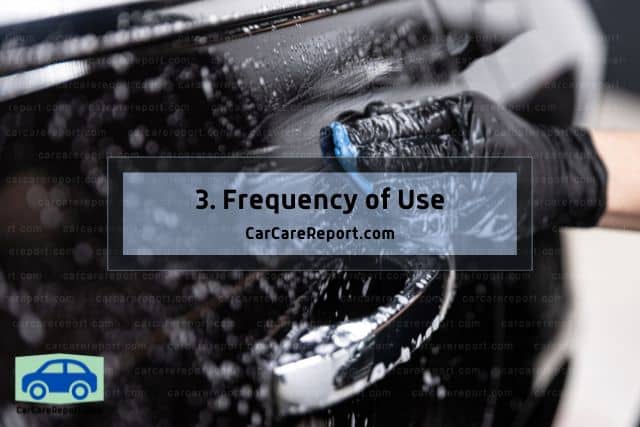
Professionals recommend that you give your car a general claying twice a year, but what type of clay bar should you use for this frequency? It is important to understand how often you should use each of the three-bar strengths and for what purpose to avoid damaging the car.
Here’s a breakdown of how frequent you should use each type:
Light Clay Bars Are Best for Regular Use
As light clay bars cause the least abrasiveness to your vehicle’s bodywork and are suited to picking up smaller particles from paintwork, they will generally be more suited to regular cleaning and detailing of your car.
Generally, this type of clay is used by those passionate about detailing their car and often clay their car at least monthly to keep their paintwork as smooth as possible.
Medium Clay Bars are the Best Choice When You Notice Something to Be Cleaned
Medium clay bars are too abrasive for regularly going over your car’s paintwork but are the standard choice for most significant staining or pollution on the surface of vehicles. So if you give your car a regular inspection every six months to a year, you can have a medium clay bar on hand to clean off pollutants that may have stuck to your bodywork.
Heavy Clay Bars Are for Professional Detailing Jobs
A heavy clay bar is for specific work where light or medium clay bars are insufficient. Bad spills and long-term build-ups on cars that have been left out in the elements for long periods will need to be dealt with by a heavy clay bar.
For this reason, it is often recommended that you leave heavy clay bars to the experts who know how to handle this kind of work. For example, when working on vehicle restoration.
4. Type of Material
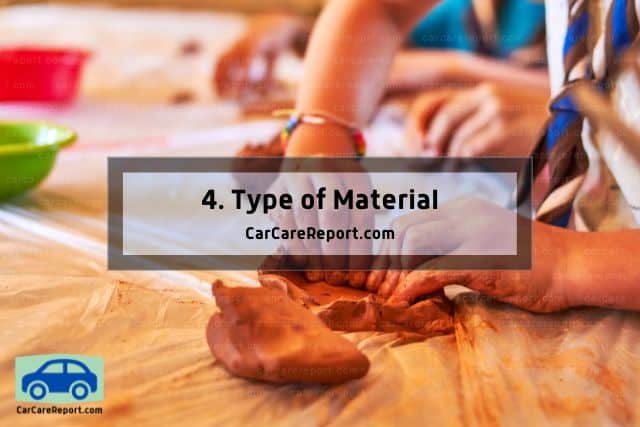
Regardless of strength or flexibility, all clay bars are made out of resins pushed together to form a bar.
These resins can be made out of one of two materials:
- Synthetic
- Natural
In terms of performance, there is no significant difference between these two materials. However, there are important differences to consider when choosing between natural and synthetic clay bars:
CarCareReport dot com is owner of this article and was first posted on Sep 19, 2022 and was updated on ..
Synthetic Clay Bars Are More Common and More Durable
Synthetic clay bars are more common and more affordable than their natural counterparts. They are also more durable and can be stored for a long time without use, as synthetic material will not degrade. They can also be used with a wide range of lubricants and generally can pick up more particles from your car per bar area.
This combination of durability, efficiency, and affordability is why synthetic clay bars are the standard used by most professional and amateur car detailers.
Natural Clay Bars Wear Out Easily and Are More Adhesive Against Bodywork
Natural clay bars are harder to find and more expensive. They degrade over time, as all-natural fibers break down after a while. Another disadvantage is that they can only be used with a lubricant graded as suitable for use with natural fibers, unlike the synthetic variety.
Still, natural clay bars offer one advantage: they are more adhesive against the surface, meaning that they will stick more against paintwork to pick up particles stuck to your car. But once a small area of the bar has been used, it will need to be removed.
Natural clay bars cannot be kept in long-term storage because they degrade. As such, they may be more suited to regular car detailers who clay their car every month and don’t mind spending a little more on their vehicle.
Frequently Asked Questions About Clay Bars
Now we know the differences between different types of clay bars and what kind of bar you will need, let’s answer a few common questions about using clay bars on paintwork.
How Do I Check if I Need to Use a Clay Bar on My Car?
To check if you need to use a clay bar on your car, clean the car thoroughly and run your fingers over the surface while still wet. The car needs to be clayed if you can still feel small bumps even after cleaning.
You can also put your hand in a clear plastic bag and run it over the surface. The plastic will snag on the small particles on the surface (if any), indicating that the car needs claying.
How Do I Prepare My Car for Claying?
To prepare your car for claying, wash it thoroughly and let it dry. This will remove all that can be cleaned without a clay bar and leave a smooth surface suitable for using the bar.
Hand-wash the car and avoid machine washes if possible, and make sure the bodywork is completely dry before starting.
First published on Sep 19, 2022 by CarCareReport.com.
Do I Need to Use Lubricant When Claying My Car?
The answer is yes; you will always need to use lubricant when claying your car, no matter what kind of clay bar you use and what you are trying to clean off.
Even lighter clay bars can be abrasive enough to cause some scraping. Without lubricant to move the clay bar and the pollutants it picks up over the bodywork, your car may be left with scratches, marring, and tough-to-remove clay pieces. Remember that natural clay bars will need a suitable lubricant grade for use with this material.
How Do I Know the Clay Bar Is Working?
You will know the clay bar is working when you see the pollutants on the clay bar as you pull it over the surface. You can also check clayed parts of your car for signs of aesthetic improvement; If any, the bar is working.
Once you notice dirt building up on the clay bar, switch to a clean part of the clay bar by physically molding and folding it with your hand ーclay bars are usually malleable enough to fold over with your fingers. For the best result, cut a small piece of the clay bar with strong scissors or a strong knife and use small parts of the bar at a time.
Do I Need to Do Anything After Using a Clay Bar on My Car?
Yes. After using a clay bar on your car, you should apply a coat of wax or sealant to protect the paintwork you have just clayed. Any small areas of scraped away paintwork will be particularly vulnerable to weathering, so protection should be applied.
Although not entirely necessary, some people also give their cars a quick polish after claying. If you choose this option, be sure to polish before applying wax to ensure anything left from the claying treatment is completely washed off. This will give the best results for a smooth, clean finish.
Related Articles
Is Using a Clay Bar Worth It? The Facts Explained
How Much Does It Cost To Wax and Buff Your Car?
Buffing VS Waxing a Car: The Differences Explained
How To Remove Rust From a Car Without Sanding
CarCareReport dot com first published this article on Sep 19, 2022..
